Imagine you’re the founder of a new tech startup in Dubai with a brilliant app idea. You have a small team, a tight budget, and an urgent need to build your product before competitors swoop in. Hiring locally, however, reveals a harsh reality – software developers in the UAE command high salaries (often around $102,000 per year on average, roughly AED 370,000).
For a cash-strapped startup, those costs can be prohibitive. This is the exact dilemma many UAE founders face: how to develop world-class software without burning through precious funding.
Increasingly, the answer lies in an unexpected ally – offshore development teams in India. By leveraging skilled Indian developers, UAE startups are cutting development costs by as much as 60% while still delivering quality, scalable products.
In this article, we’ll explore why and how offshoring to India has become a game-changer, with stats, stories, and actionable insights for founders and CTOs looking to do more with less.
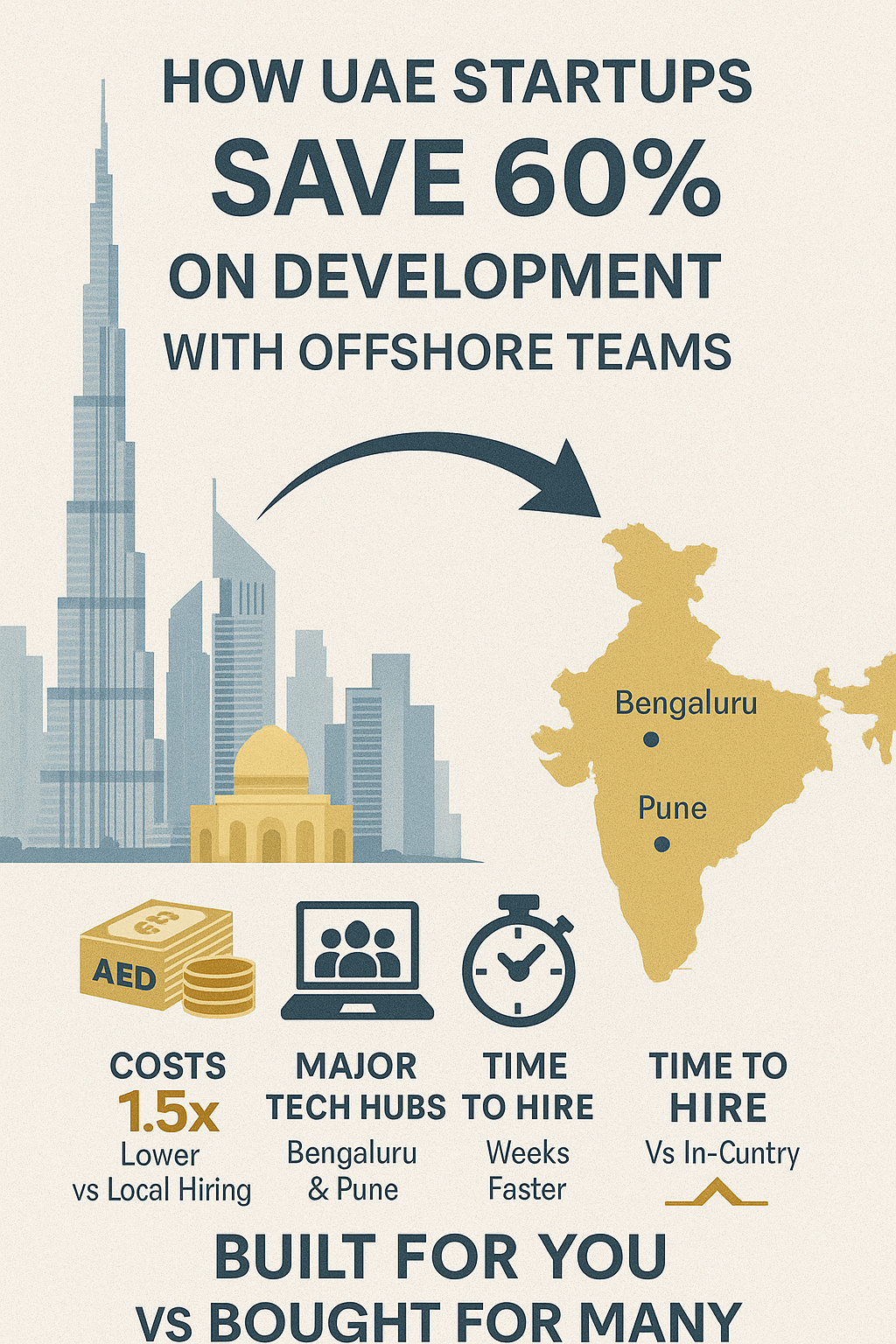
The High Cost of Local Development in the UAE
The UAE’s tech scene is booming, especially in hubs like Dubai and Abu Dhabi, but hiring local tech talent comes at a premium. There’s a talent crunch – demand for skilled software engineers, AI specialists, and developers far outstrips the local supply. In fact, “software development” is among the top skill shortages in the UAE job market, meaning companies fiercely compete (and pay top dirham) for qualified developers.
This demand, coupled with a high cost of living, pushes salaries into global territory. A mid-level developer in Dubai might expect a salary and benefits package equivalent to that of a developer in Silicon Valley.
For example, as noted above, an average software engineer’s pay hovers around $100K/year in the UAE. Hiring a full in-house team of developers, designers, and testers locally can thus eat up a startup’s runway very quickly.
Why are costs so high? Beyond salaries, local hiring entails expenses like office space, equipment, employment visas, healthcare, and potentially relocation packages. Startups also face competition from larger enterprises and government projects that can afford to pay even more.
It’s not uncommon for promising UAE startups to stall because they simply can’t afford the team needed to build their product. This is where offshore development becomes not just attractive, but often essential.
Read: Pros and Cons of Nearshore Outsourcing
Offshore Development – A Game Changer for Startups
Offshore development means building your software with a team located in another country (usually where talent is abundant and labor costs are lower). Unlike hiring random freelancers, an offshore development team often works as an extension of your company – dedicated developers, QA engineers, and project managers who collaborate remotely on your projects.
Initially popular with large Western corporations, this strategy has trickled down to the startup world. Today, even early-stage companies in the UAE are tapping into offshore teams to punch above their weight.
.avif)
The draw is obvious: drastically lower costs without sacrificing talent quality. By offshoring software development, companies can save up to 60% of development expenses on average. This isn’t just a marketing figure – it reflects real differences in salaries and operating costs.
For a UAE startup, trimming the dev budget by 60% could mean the difference between a 6-month runway and 15-month runway – enough time to build an MVP and even iterate on user feedback. Cost savings are the immediate benefit, but they’re not the only one:
1. Access to Global Talent
Offshoring opens the door to a worldwide pool of specialists. Instead of being limited to who is available (and affordable) in Dubai, you can work with top-notch developers anywhere. This is crucial when niche skills are needed. An offshore development center (ODC) essentially gives startups a vast talent pool on call.
.avif)
2. Faster Time-to-Market
With a distributed team, work can progress virtually around the clock. Your UAE team might wrap up in the evening, but your offshore engineers in India can continue coding overnight. This “follow-the-sun” model accelerates development. While you sleep, your offshore team works – squashing bugs and building features – so you wake up to progress.
3. Scalability & Flexibility
Offshore teams offer the flexibility to scale up or down quickly. Need three extra developers for two months to meet a deadline? It’s far easier (and cheaper) to allocate additional offshore resources than to hire locally on short contracts. If a project’s scope changes, you can adjust team size without long-term commitments or layoffs. This agility is invaluable in the volatile startup journey.
Focus on Core Business: Offloading development to a trusted team means founders can focus on strategy, fundraising, marketing, and customer acquisition – the core business tasks – rather than juggling day-to-day coding management. Meanwhile, all the HR, infrastructure, and administrative burdens of managing an in-house dev team are handled by your offshore partner.
Why India? The Perfect Offshore Partner for UAE Businesses
When UAE startups look offshore, India consistently emerges as the top choice – and with good reason. India has spent decades cementing its reputation as the “backbone of global IT outsourcing,” and it offers a unique combination of advantages ideally suited to the UAE’s needs:

1. Cost Efficiency
India offers world-class tech talent at a fraction of UAE costs. Salaries for developers in India are substantially lower due to lower living costs. To put it in perspective, the average annual salary for a software engineer in India is around $11,000 (≈AED 40,000) – nearly one-tenth of the UAE average. Even after factoring in outsourcing vendor fees or higher rates for senior specialists, companies still report savings on the order of 50-60%.
One survey noted that hiring Indian software developers can cut development costs by up to 60% while delivering “world-class” solutions. In practical terms, a project that might cost AED 1,000,000 to develop locally could potentially be completed for AED 400,000 or so via an Indian ODC – without compromising on quality.
2. Massive Talent Pool
India’s tech talent pool is second to none. The country boasts over 5 million software developers (roughly the population of an entire medium-sized country!), and this number is expected to reach 6.5 million by 2025. Each year, Indian universities produce around 1.5 million engineering graduates, many of whom enter IT and software fields.
For a UAE startup, this abundance means you’re almost guaranteed to find developers with the exact skill set you need, whether it’s a React Native mobile developer, a UI/UX designer, or a cloud infrastructure expert. You are not stuck paying a premium for whoever is available locally – you can cherry-pick top talent from an enormous pool of candidates.
.avif)
3. Broad Expertise
Thanks to its huge IT industry, Indian developers have experience across the full spectrum of technologies and industries. Indian outsourcing firms and dev teams have built software for every sector and tech stack imaginable – fintech platforms, e-commerce, AI and machine learning, enterprise SaaS, blockchain, you name it.
Need an AI algorithm engineer or a Salesforce integration specialist? It might be rare in the GCC, but India likely has many to choose from. This depth and breadth of expertise means a UAE startup can find exactly the right skills offshore instead of making expensive compromises locally.
4. English Proficiency & Cultural Compatibility
Communication is key in any development project. Fortunately, English is effectively the lingua franca of India’s tech industry. Most Indian developers and project managers are fluent in English, which minimizes the risk of misunderstandings. Additionally, India and the UAE have had close business and cultural ties for generations. Many Indians live and work in the Gulf, and many Indian IT firms have clients in the Middle East.
Start Saving 60% on Development—Talk to Our Experts Today
As a result, cultural compatibility is high – Indian teams are adept at working with UAE businesses’ norms and can integrate seamlessly into mixed teams. There’s a strong understanding of business etiquette, a shared emphasis on building long-term relationships, and even overlapping tastes (your Indian counterparts might be as excited about cricket or the latest tech gadgets as you are!). This cultural closeness makes the working relationship smoother and builds trust.
5. Time Zone Advantage
Geographically, India is only about 1.5 hours ahead of the UAE (India is GMT+5:30, UAE is GMT+4). This small difference is a sweet spot – close enough for real-time collaboration during the UAE workday, yet with a bit of offset that can be leveraged for extended development cycles.
Many UAE companies find they can have daily stand-up meetings conveniently in the late morning or afternoon, when both UAE and Indian teams are online. Then, after UAE office hours, the Indian team can continue to make progress into their evening.
It’s not quite the drastic night-vs-day scenario you’d have working with, say, a Silicon Valley team – instead it’s an almost overlapping schedule that still allows handing off work for near-continuous productivity. Essentially, India offers a “work while you sleep” benefit without the challenges of large time gaps.
 (1).avif)
6. Mature Outsourcing Ecosystem
India’s IT outsourcing industry is decades old and very mature. Cities like Bangalore, Hyderabad, Pune, and Chennai have entire ecosystems of development centers, startup incubators, and tech vendors. This maturity translates into better reliability and process standards.
Reputable Indian development firms adhere to international best practices (Agile methodology, DevOps, quality assurance processes, etc.). Many hold certifications like ISO 27001 (for data security) or CMMI, and have experience working with international data protection laws.
For a UAE startup, partnering with an established Indian firm or hiring experienced Indian developers means you’re not starting from scratch – you’re plugging into a well-oiled machine. The result: projects hit the ground running and proceed efficiently.
7. Proven Track Record
Perhaps most reassuring, India has a proven track record of success in offshore development. It’s not an untested idea; it’s a path many companies (big and small) have trodden successfully. Global tech giants (from Microsoft and Google to SAP and IBM) have large R&D and support centers in India.
Even UAE-based enterprises routinely outsource IT projects to India or maintain satellite tech offices there. This history means there’s plenty of accumulated knowledge on how to make offshoring work. And as a startup, you can tap into that collective experience, avoiding pitfalls and leveraging strategies that have been refined over years.
Read: Dedicated Development Team vs In-House Development
Breaking Down the 60% Cost Savings: How offshore teams in India make savings possible for a UAE startup
Saving “60% on development” isn’t magic – it’s arithmetic driven by tangible differences in expenses.
Here’s how offshore teams in India make such dramatic savings possible for a UAE startup:
.avif)
1. Lower Salaries
This is the single biggest factor. As mentioned, a software developer earning $100k (AED ~367k) in the UAE might have an equivalent counterpart in India earning around $25k (AED ~92k) for similar experience and skill (even less if we use national averages). That’s a 3-4x difference in base pay. Multiply that across a team of 5–10 people and over 12+ months of development – the salary savings alone can approach the 60% mark.
According to industry data, on-site development can cost up to 60% more than offshore, which aligns with the idea that offshoring cuts costs ~half or better. Put simply, you might afford a team of three Indian engineers for the cost of one UAE engineer in some cases.
2. Reduced Overhead & Benefits
When you hire locally, salary is just one part of the cost. There’s also health insurance, end-of-service gratuities, housing allowances, annual airfare (common for expatriate staff in the UAE), and other benefits. With an offshore team, these perks are often not your responsibility – if you’re working through an offshore development company, they handle local employment benefits for their staff. Even if you hire contractors directly, you typically pay an agreed hourly or monthly rate without worrying about add-ons.
Office space and equipment is another overhead: in the UAE, office rent is significant, especially in business hubs. But a remote team in India works from their own office or homes. You’re not footing the bill for their desks, laptops, electricity, or pantry snacks – those costs are borne by the offshore provider or offset by the lower cost of real estate in India. Some sources note that by offshoring, businesses save on infrastructure and rent costs as well, which further contributes to that 60% figure.
3. Economies of Scale
Offshore development firms can spread costs across multiple clients. For example, they might have a security team, QA automation tools, or devops infrastructure that benefits all their projects. As a client, you get the advantage of these investments without having to pay for them alone. In essence, the cost of certain tools, training, and processes is amortized. This means your project’s effective cost is lower than if you tried to do everything in-house.
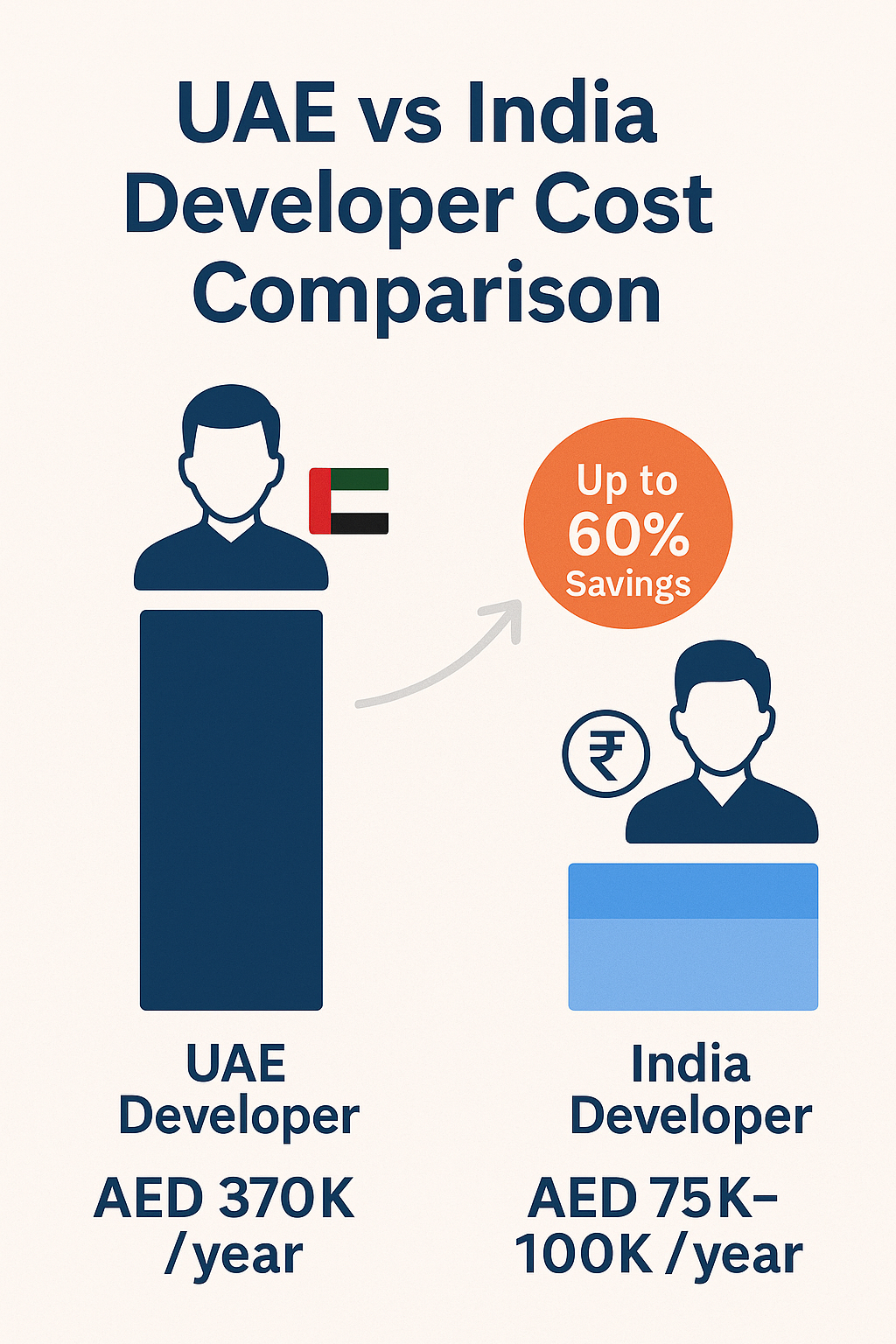
4. Faster Hiring and Onboarding
Time is money, especially for startups. Hiring in the UAE can be a lengthy process – posting jobs, interviewing candidates (who might have multiple offers), negotiating salaries, and then waiting out notice periods. With offshore teams, you can often ramp up much faster. Need a couple of iOS developers next month?
An offshore provider in India might allocate them within days. Shaving weeks or months off your hiring timeline is essentially a cost saving – it means development starts sooner and your product hits the market earlier (which can mean earlier revenue).
While this isn’t a direct line item saving, it reduces opportunity cost and the risk of project delays. In financial terms, if faster time-to-market captures even a month of extra sales or gives you a competitive lead, that’s extremely valuable.
5. Focus on Core Tasks
Consider the opportunity cost of a founder or CTO spending hours on coding or managing junior developers. By entrusting development to a capable offshore team, key team members in the UAE can focus on strategic activities that add value – meeting investors, signing partners, refining the product vision, or improving customer experience.
This focus can indirectly save money by driving growth. It’s hard to quantify, but startups often attribute part of their success to being able to focus on core business while the offshore team handles the heavy lifting of development. As one outsourcing expert put it, offshoring lets you buy time and productivity at a discount – you essentially purchase freedom to focus where it matters.
Hire Top Offshore Talent from India—Get a Free Quote Now
6. Flexible Scaling (No Bench Costs)
In a local scenario, if you hire 5 developers and midway through the project you realize you only need 3 for the next month, you’re still paying 5 salaries (or you have the unpleasant task of firing people and later re-hiring, which has its own costs). Offshore teams offer flexibility: you can usually scale the team size up or down with relative ease. Many Indian development partners allow adjustments in team composition with a few weeks’ notice.
This means you pay for what you use. Over the lifecycle of a project, this flexibility can yield big savings. You avoid long periods of under-utilized staff. For instance, after a big release, you might scale down development efforts for a while – with an offshore contract, you could reduce the team size and costs accordingly, something not feasible with fixed in-house employees.
7. Quality and Rework Savings
It might seem counterintuitive, but saving money isn’t just about paying less – it’s also about avoiding costly mistakes. A skilled offshore team that has delivered many projects can often build software more efficiently and with fewer errors than an over-stretched small in-house team learning on the fly. Better architecture and testing means less money spent on bug fixes and rewrites down the road.
In other words, you’re not just doing it cheaper, you’re doing it right (or at least better), which prevents the scenario of paying twice to get something done. Access to specialized skills (like a part-time UX expert or a cloud architect from the offshore provider’s bench) can further ensure you build it correct the first time. These quality-related savings, while hard to measure upfront, can be substantial over the course of a product’s development.
Ensuring Quality and Productivity with Offshore Teams
Here’s why UAE startups can save money and get quality results:
A natural concern arises: Sure, it’s cheaper – but will the work be any good? The good news is that cost-effective doesn’t mean low-quality when it comes to Indian development teams.
.avif)
1. Skilled & Experienced Workforce
The Indian IT workforce is not a bargain-bin; it’s filled with highly educated, often very experienced professionals. Many have previous experience on global projects for demanding clients in the US, Europe, and the Middle East. They bring proven expertise in coding, design, and project management.
Also, because India’s tech sector is so large, developers often specialize – meaning you might get a true expert in, say, fintech app security or e-commerce UX, rather than a generalist. This specialized skill can lead to better output and innovative solutions that you might not achieve with a stretched-thin local team.
2. Strong Work Ethics and Continuous Learning
Indian developers are known for their dedication and continuous upskilling. Culturally, there is a strong emphasis on education and staying up-to-date with the latest technologies. From a practical standpoint, many Indian outsourcing firms invest heavily in training their staff on new frameworks, tools, and best practices to stay competitive.
As a client, you benefit from a team that’s already trained on the latest React version or that new cloud service – you don’t have to invest in that training yourself. This contributes to higher productivity and quality of work.
3. Agile and Efficient Processes
Because of the maturity of the offshore industry in India, many teams operate with well-defined Agile methodologies. Daily stand-ups, sprint planning, and iterative development are common. Modern collaboration tools (Jira, Trello, Slack, Zoom, etc.) mean that an offshore team can effectively mimic the feel of a local team. You’ll often have full transparency into the work – user stories, bug trackers, version control – everything accessible in real-time.
Frequent demos and deliverables keep quality on track. In fact, startups often report that a good offshore team can sometimes outpace an in-house team in terms of velocity, because the offshore team’s entire job is to focus on your development (they’re not getting pulled into internal meetings or side-tasks as often).
4. Time Zone Productivity Gains
We touched on the follow-the-sun advantage, but it’s worth noting from a quality perspective: a staggered work schedule can actually improve quality and responsiveness. If your UAE-based product manager logs an issue at 6 pm, it might be resolved by the time they check in the next morning, thanks to the Indian team working later.
This near-24/7 cycle reduces downtime and waiting, keeping momentum high. Urgent bug fix needed overnight? An offshore team can handle it while your UAE team rests, maintaining a healthier work-life balance for everyone.
5. Proven Outcomes
Perhaps the best quality assurance is hearing about others who’ve succeeded. Offshore partnerships have led to tangible success stories. For example, an iValuePlus case study mentions a fintech startup that built their MVP with an offshore team, cutting development costs by 50% and reducing time-to-market by 30% – notably, they achieved speed without ballooning cost.
The product launched successfully and met quality benchmarks, proving that offshoring can deliver high-caliber results. Many UAE startups (often behind the scenes) have similar stories of quietly using Indian developers to power their apps or platforms, which then go on to impress users and investors alike. These real-world outcomes build confidence that offshore teams can meet the quality bar.
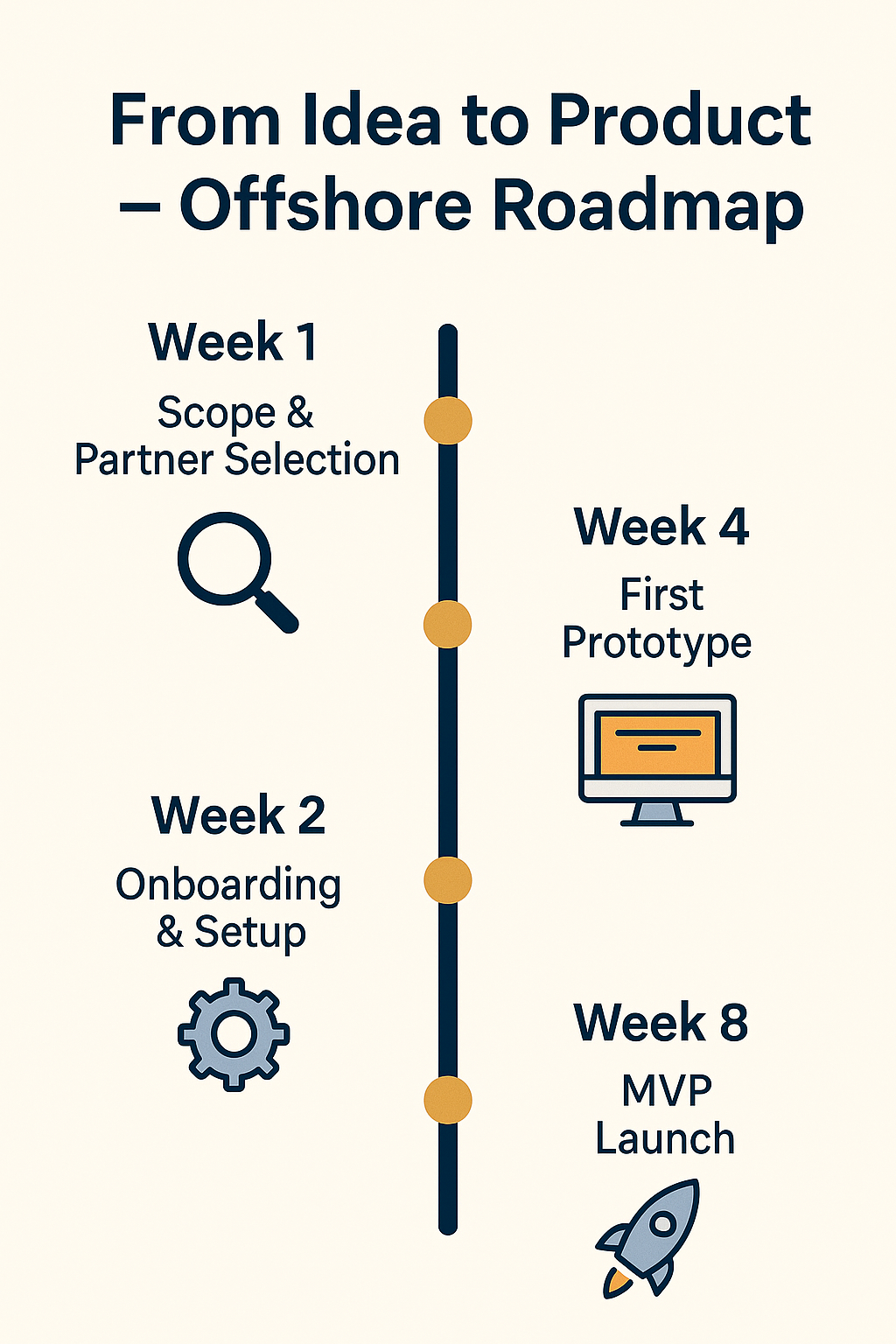
6. Maintaining Control and IP
Quality isn’t just about code; it’s also about maintaining control over your project and intellectual property. Reputable offshore development partners understand this. They typically sign strict NDAs and contracts that ensure you own the code and IP from the project.
Many operate under international arbitration standards for any disputes. Tools like Git repositories and project management dashboards give you continuous oversight. In practice, your offshore developers can feel like just an extended part of your in-house team – you set the tasks, monitor progress, and steer the product vision. This level of control means you can enforce your quality standards and coding guidelines as if the work were happening in the next room.
Read: Offshore vs Nearshore
Case Study: From Dubai Dream to Global App – Powered by an Indian Offshore Team
To illustrate the impact of offshoring, consider the story (a composite of real scenarios) of DesertTech, a fictitious Dubai-based startup with very real challenges.
DesertTech’s Dilemma
A vision to create a fintech app that would streamline peer-to-peer payments across the Middle East. Investors were interested, but only if he could prove the concept quickly. Local development quotes for an MVP (minimum viable product) came in around AED 1 million, which was way above his small seed budget. Hiring even a few in-house developers for 6-12 months would exhaust his funds, and delay would mean someone else might beat him to market.
The Offshore Solution: Through a reference, he connected with an offshore development firm in Bangalore, India. They proposed a dedicated team of 1 project manager, 4 developers (a mix of frontend and backend), and 1 QA engineer to work on his app. The projected cost? Roughly 40% of the best local quote – about AED 400k for several months of work, all-inclusive. Skeptical but hopeful, Ahmed signed on. Within two weeks, the offshore team was assembled and kicking off the project via video calls.
Scale Smarter, Not Costlier—Build Your Offshore Team
How It Unfolded: Communication was established with daily Zoom stand-ups at 9am UAE time (10:30am in India) – a time that worked well for everyone. Despite never meeting in person, Ahmed quickly felt like the Indian developers were part of his company. They learned the nuances of UAE banking regulations and local user preferences eagerly.
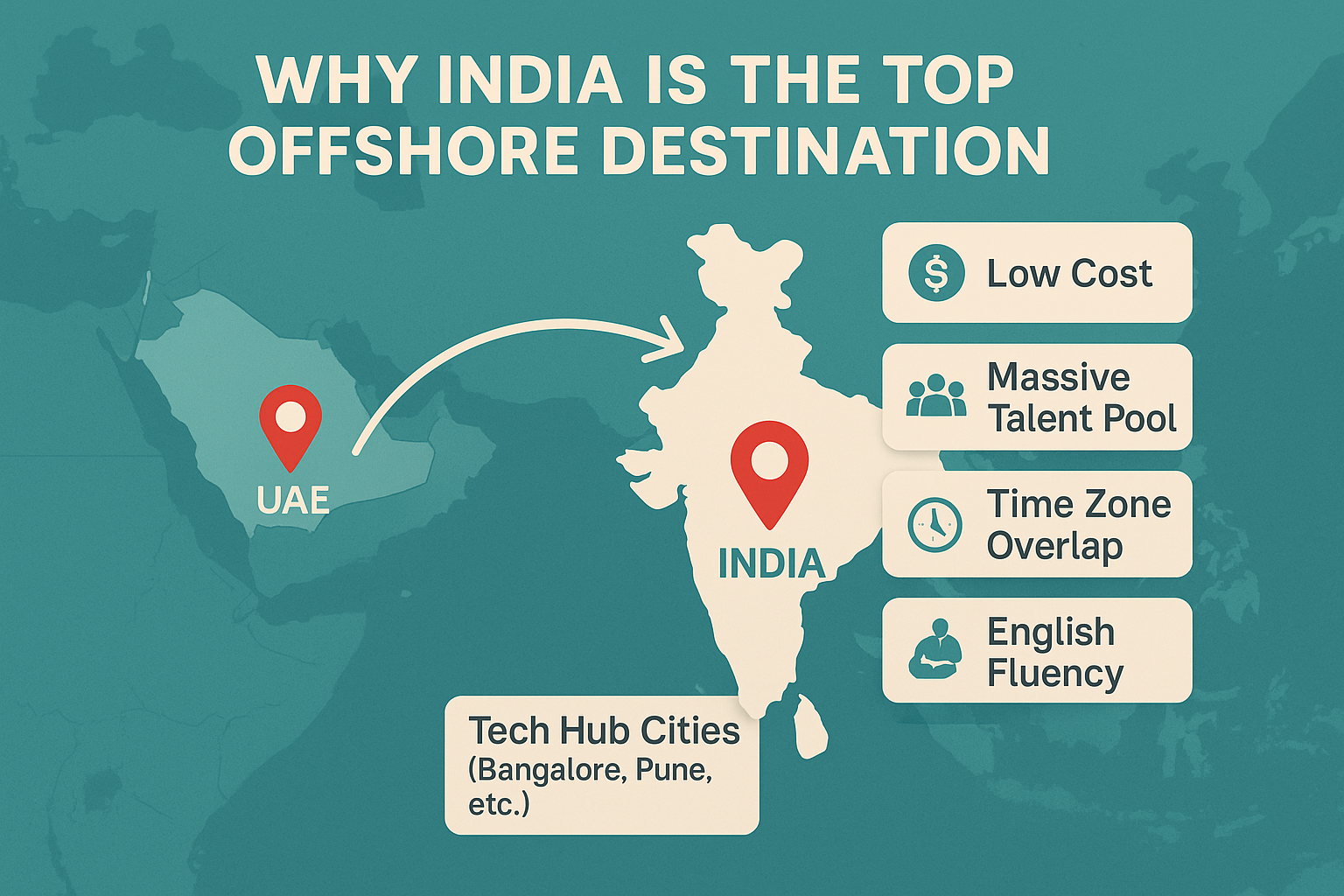
One developer had prior experience building a payment wallet app for an Indian bank, which became invaluable domain knowledge. While Ahmed focused on securing partnerships with local banks and navigating compliance, his offshore team iterated rapidly on the app. They set up a staging server where Ahmed and UAE-based advisors could test new features every week.
Results Beyond Savings: In four months, DesertTech had an MVP app ready – a timeline Ahmed initially thought impossible. The total spend was about AED 500k, slightly above estimate due to some extra features added, but still roughly 50% less than doing it in the UAE. But it wasn’t just about cost:
-
The quality of the app was excellent. It passed security tests and user beta tests with flying colors. The UX design, done by an Indian designer brought in part-time, was polished and tailored for a Middle Eastern audience (the designer even adjusted the color palette and fonts to suit regional tastes).
-
With the money saved, Ahmed was able to allocate budget to marketing and compliance – he hired a local marketing consultant to prepare for launch and a legal advisor to ensure all fintech regulations were addressed. If he’d blown the budget on development alone, these critical pieces might have been neglected.
-
The app’s development benefited from the extended hours of work. A last-minute change requested by a potential investor was implemented over a weekend by the offshore team, ready in time for a Monday presentation – something that might have required burning out an in-house team or simply saying “we can’t do it that fast.”
-
Perhaps most telling, the startup’s story impressed investors: here was a founder who, with limited resources, managed to build a solid product quickly by smartly leveraging global talent. It demonstrated business savvy and the ability to execute – traits investors love. DesertTech went on to raise a larger round, crediting the offshore team for helping them reach that milestone.
Tips for Successfully Working with Offshore Teams
Here are some actionable tips and best practices to ensure your offshore collaboration delivers great results:
.avif)
Embracing offshore development is a strategic move, but success requires the right approach.
1. Choose the Right Partner
Do thorough due diligence when selecting an offshore development company or team. Look for proven experience (case studies or client testimonials), expertise in the technologies you need, and strong communication skills. Interview the actual developers if possible, not just the sales reps. A good cultural and technical fit will set the foundation for success.
2. Start Small and Build Trust
If you’re unsure, start with a pilot project or a smaller milestone. This allows you to evaluate the offshore team’s performance on a limited scope before committing to a long-term engagement. Once trust is built and you see the quality is high, you can confidently ramp up the work. Many startups begin with a trial sprint or a prototype phase as a test.
3. Set Clear Requirements and Goals
It’s crucial to communicate your project requirements, acceptance criteria, and business goals clearly to the remote team. Ambiguity can lead to misaligned expectations. Provide written user stories, design mockups, and even examples of apps you like. The clearer the vision, the better the output. Good offshore teams will ask questions – that’s a positive sign that they’re engaged and want to understand your needs fully.
4. Establish Strong Communication Rhythm
Treat the offshore team as an extension of your local team. Schedule regular check-ins – daily stand-ups, weekly planning/review meetings, etc. Utilize tools: for instance, use Slack or Microsoft Teams for quick chats and updates, Jira or Trello for tracking tasks, and video calls for more personal interaction.
Keep communication lines open and responsive. It helps to designate a point person on your side (maybe the CTO or a project lead) to liaise with the offshore project manager daily. Remember, it’s daytime in India when it’s morning in the UAE – leverage those overlapping hours for real-time collaboration.
5. Bridge the Cultural Gap
Although India and the UAE work together well, minor cultural differences or work style differences can pop up. Be mindful and patient about these. For example, Indians may be inclined to say “yes” to assignments out of politeness or optimism – encourage an environment where they can be honest if something is unclear or timelines are too tight.
Be aware of local holidays or festivals in your offshore team’s region (e.g., Diwali in India) and plan around them (just as they will respect UAE holidays). Small gestures like exchanging holiday greetings, or learning a few words of your team’s language (even a “Namaste” or “Shukriya” for thank you) can go a long way in building rapport.
6. Align Time Zones Thoughtfully
While a bit of time difference is advantageous, you should still ensure there is enough overlap for live collaboration. Ensure your offshore team’s work hours have at least 3-4 hours of overlap with your UAE team’s day. This makes a huge difference in agility – questions get answered quickly, blockers are removed faster, and everyone feels in sync. If needed, adjust some work hours on either side to create a routine that suits both (many Indian teams are used to shifting their schedules slightly for overseas clients).
7. Use Agile Methodology
Embrace Agile practices to manage the work. Break the project into sprints with definable outputs. Have sprint planning, demos, and retrospectives with the offshore team participating fully. Agile’s emphasis on iterative delivery and constant feedback is perfect for remote collaborations because it surfaces issues early and promotes continuous improvement. Plus, you get to see progress frequently, which builds trust.
 (1).avif)
8. Protect Your Intellectual Property
Always have the legal basics covered. Sign an NDA and ensure the contract clearly states that you own the code and intellectual property developed. Reputable firms won’t mind this – it’s standard practice. Additionally, use private code repositories (like GitHub or GitLab) under your control or a shared control to host the code.
This way, you always have access to the latest codebase. If you’re particularly concerned, consider splitting critical components across teams (though this can add complexity). However, with a trusted partner, usually robust contracts and perhaps a review of the outsourcing firm’s security practices will suffice to make sure your IP is safe.
 (1).avif)
9. Plan Occasional Face-to-Face (If Possible)
While not strictly necessary, if resources allow, consider an in-person visit at some point. Meeting your offshore team in person – whether you fly to Bangalore or they visit Dubai – can significantly strengthen the working relationship. Face time builds camaraderie and a deeper mutual understanding.
Post-pandemic, many teams operate 100% virtually, but even a yearly meetup or inviting key offshore members to your product launch in the UAE can pay dividends in team cohesion. If travel isn’t possible, even arranging a longer “virtual team building” session or celebrating major milestones via video call can humanize the partnership beyond just tasks and tickets.
10. Monitor Progress and Give Feedback
Keep an eye on the deliverables and provide quick feedback. If something isn’t as expected, speak up early – offshore teams appreciate clear feedback so they can correct course. Use KPIs for progress if that helps (e.g., number of features completed, sprint velocity, etc.), but also remember software development can have unforeseen challenges.
Maintain a bit of flexibility in your expectations, focusing on the end goals. When the offshore team does well, acknowledge their success and celebrate it just as you would with an in-house team. Positive reinforcement motivates everyone to keep the quality high.
Conclusion: Scaling Smart with Offshore Teams
For UAE startups hungry to innovate, grow, and lead, offshore development teams in India present an unprecedented opportunity to scale smartly and efficiently. In a business climate where every dirham and every day counts, this model allows you to convert limited capital into maximum output – more code written, more features built, more customers satisfied – all while staying within budget.
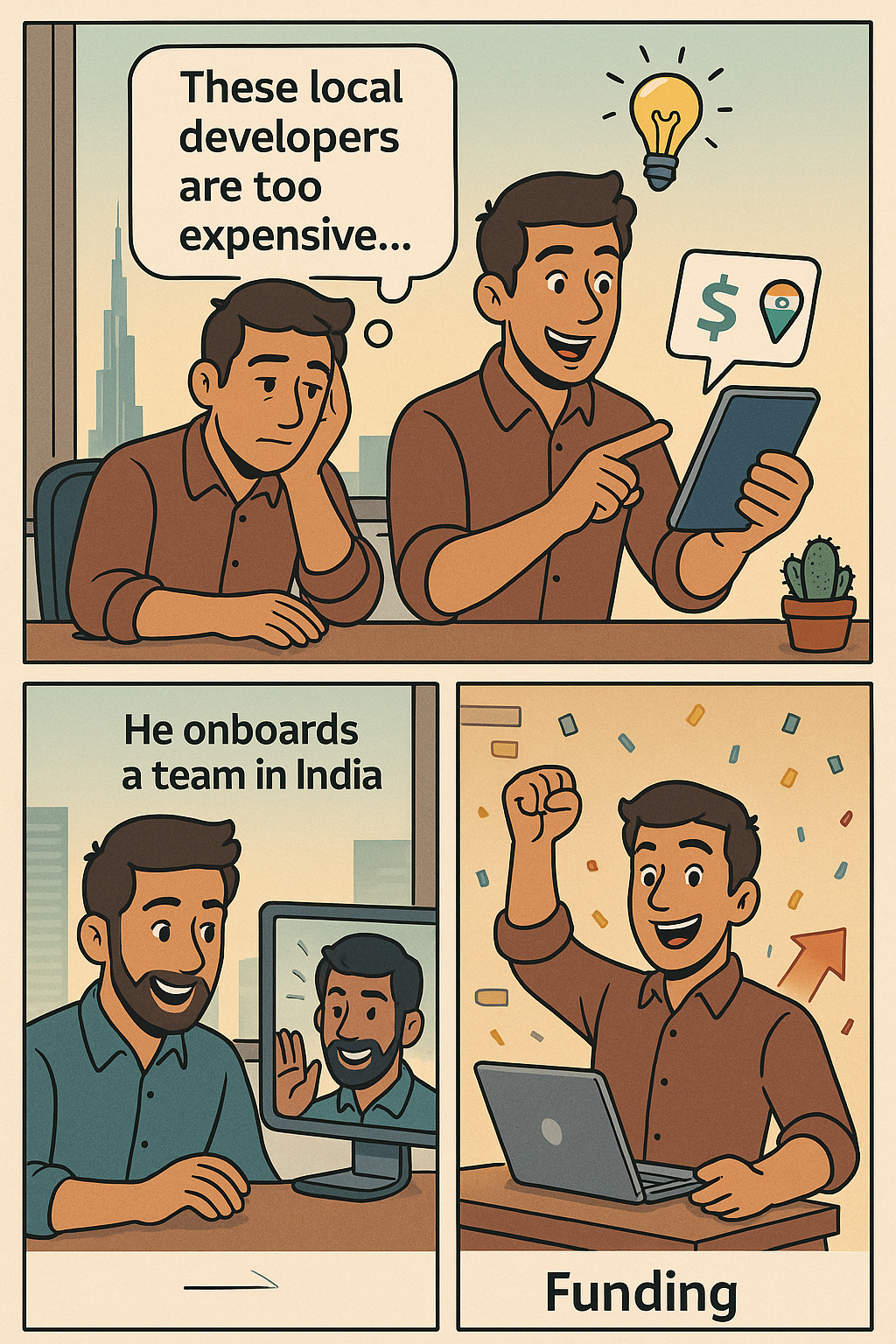
We’ve seen how leveraging India’s vast talent pool can cut costs ~60%, speed up development, and even improve the breadth of expertise available to your project. Just as importantly, it lets you, as a founder or CTO, focus on strategic growth knowing a capable team is handling the technical build.
If you’re a UAE startup founder or tech leader reading this, here’s a friendly challenge: imagine what you could build if your development costs were half of what they are now. What new features, products, or even additional startups could you launch with those savings? Offshore development in India offers you that possibility. Of course, it requires an open mind and willingness to collaborate across borders – but the greatest entrepreneurs thrive on turning challenges into opportunities.
Read: Benefits of Hiring a Software Development Company
Don’t let high local costs stall your big ideas. Whether you’re brainstorming a fintech platform, the next e-commerce marketplace, or an AI-driven service, remember that a world-class team is out there eager to help you build it – and you can engage them at a fraction of the usual cost. Many who have walked this path are now reaping the rewards: faster growth, efficient operations, and products that can stand toe-to-toe with globally developed competition.
In closing, offshore development isn’t just a way to save money – it’s a way to amplify your startup’s potential. It’s about doing more with less, scaling up without the growing pains, and being agile enough to seize market opportunities. The UAE’s dynamic, innovative startup ecosystem paired with India’s tech prowess is a combination that spells success.

So, if you’re ready to turn your constraints into strengths, consider taking that next step: explore an offshore partnership, run a trial, and see the results for yourself. You might just find that your startup can soar higher when your team stretches from the Emirates to the shores of India.
Ready to save costs and supercharge your development? There’s no better time to act. Leverage the best of what offshore talent offers and join the ranks of UAE startups who have discovered the 60% advantage. Your future self (and your CFO) will thank you for it.
FAQs
Q1. How do offshore development teams actually save costs for a startup?
A: Offshore development teams save costs primarily through lower labor and operational expenses. Developers in countries like India, Pakistan, Ukraine, or the Philippines often have significantly lower salary requirements than those in the UAE, due to differences in living costs.
For example, if a UAE developer costs $8,000 per month and an equally skilled offshore developer costs $3,000, the saving is substantial. Additionally, with offshore teams you save on overhead costs – there’s no need for extra office space, equipment, or expensive local benefits.
Many offshore developers work remotely or in offshore development centers run by third-party firms, so you’re not directly bearing those infrastructure costs. All told, startups can reduce development expenses by up to 60% by offshoring, allowing them to reallocate that budget to other areas like marketing, sales, or further product development.
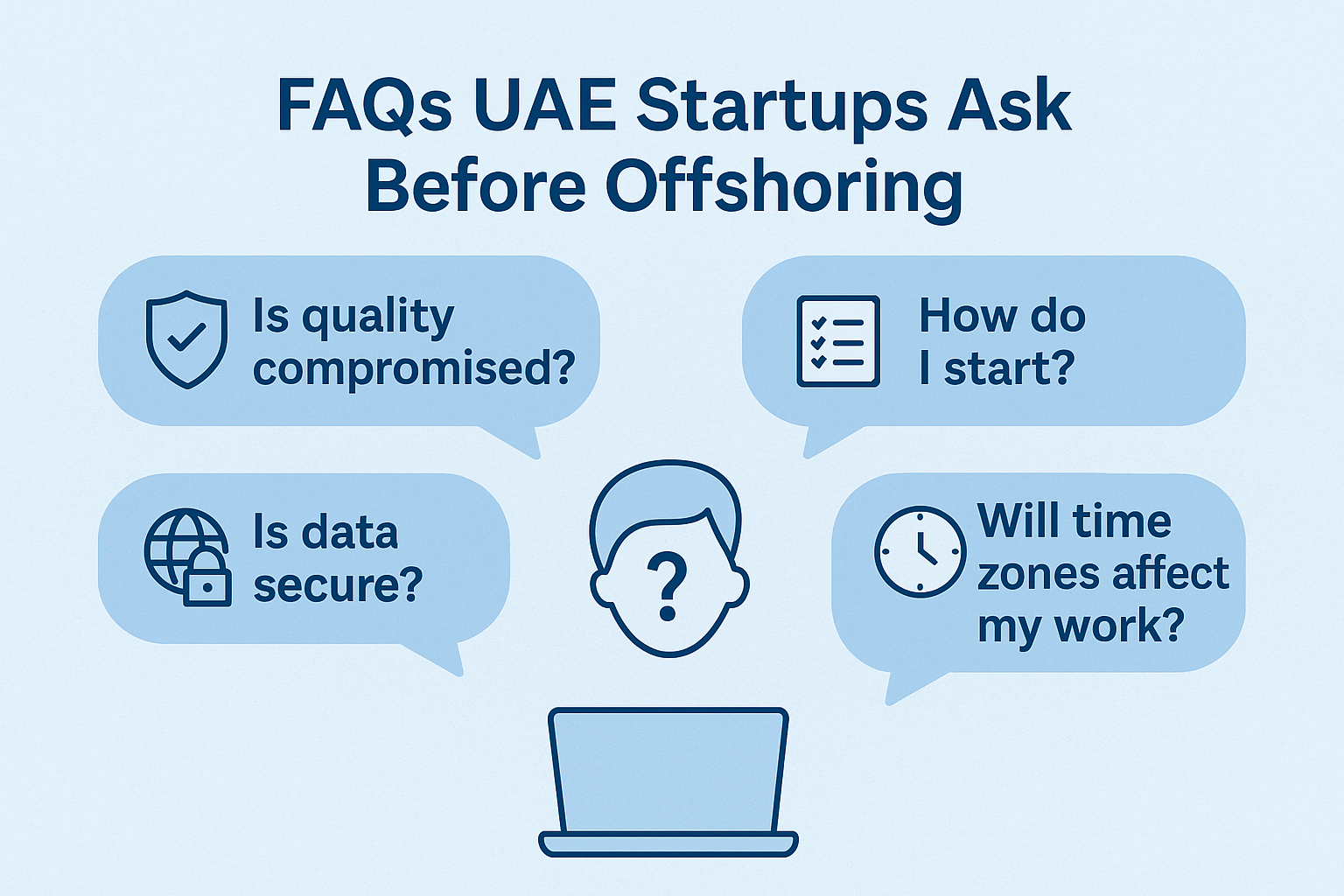
Q2. Isn’t communication a problem when working with offshore teams, especially across different time zones?
Communication is a challenge at first, but it can be managed effectively with the right approach. Modern collaboration tools (Slack, Microsoft Teams, Zoom, etc.) make it easy to stay in touch daily. Many UAE startups set up a routine – for instance, a quick daily video stand-up that overlaps with the offshore team’s schedule – to keep everyone on the same page. Given the UAE’s time zone (Gulf Standard Time), there’s often a decent overlap with teams in South Asia, Eastern Europe, or Africa, so real-time communication is feasible.
The key is to establish clear communication protocols: define work hours overlap, use project management tools to track tasks, and encourage a culture where developers ask clarifying questions proactively. With these practices, distance becomes much less of an issue. In fact, many teams report that after an initial adjustment period, working with an offshore team feels as seamless as if they were in the next room.
Q3. How do I ensure the quality of work when hiring an offshore development team?
Ensuring quality when offshoring is very achievable – it just requires setting up some structured processes. First, choose your offshore partner carefully: look for teams or agencies with strong reputations, client testimonials, and perhaps even specialization in the technology you need. Once development begins, implement quality assurance measures such as code reviews, automated testing, and milestone-based evaluations.
Treat your offshore developers as an extension of your team by sharing your coding standards and best practices from the get-go. Many startups have a senior developer or CTO on the UAE side periodically audit the code and provide feedback. Frequent demos are also useful – have the offshore team show progress every week or two so you can catch any issues early.
By combining these practices with clear specifications and open communication, you can maintain high quality. In fact, many startups find that offshore teams can deliver excellent, professional work – they often have experience serving global clients and understand the importance of quality in retaining business.

Q4. What about data security and IP protection when working with offshore teams?
Data security and intellectual property (IP) protection are valid concerns, but they can be addressed with the right precautions. Reputable offshore development companies take security seriously – after all, their business depends on trust. You should always sign proper contracts, including Non-Disclosure Agreements (NDAs) and IP ownership clauses, before starting the work. This ensures that you legally retain all IP rights to the work product.
Additionally, implement security best practices: use secure communication channels (VPNs, encrypted messaging), and control access to your code repository. You can grant offshore developers access to only the parts of the system they need. Many companies set up development environments with role-based permissions. It’s also wise to inquire about the offshore team’s internal security protocols (e.g. do they follow ISO standards, do they have secure networks, etc.).
By doing due diligence and setting technical safeguards, UAE startups can work with offshore teams while keeping their sensitive data and IP safe. Remember, thousands of companies large and small safely outsource development – the key is a combination of legal agreements and smart IT practices.
Q5. Which countries are popular for offshoring development for UAE startups?
UAE startups tend to offshore to a mix of regions, depending on their needs. India is one of the most popular due to its vast pool of English-speaking developers, cost-effectiveness, and geographic proximity (just a few hours ahead in time zone). You’ll find Indian developers in virtually every technology stack, from mobile apps to AI. Pakistan and Egypt are also emerging as offshoring destinations, especially for Middle Eastern startups, as they combine relatively lower costs with cultural and time-zone proximity.
Eastern European countries like Ukraine, Poland, and Romania are favored when startups are looking for very strong engineering talent (particularly in fields like blockchain, fintech, or complex software) at rates still lower than Western Europe or the UAE. The Philippines and Vietnam are known for software development and also for tasks like UI/UX design and QA testing.
Ultimately, the best country to choose can depend on the specific skills you need, budget, and comfort with the partner – but the good news is that UAE startups have a wide range of options across Asia, Eastern Europe, and Africa, all offering different strengths. Many founders will evaluate a shortlist of candidates or firms from multiple countries to see which fit feels right in terms of expertise, communication, and value.
Q6. How can a UAE startup get started with an offshore development team?
Getting started with offshoring is easier than it might seem. Here are a few steps to kick off the process:
-
Define Your Needs: Start by clearly outlining the roles or skills you need, the scope of work, and your budget. Are you looking for one or two developers to augment your team, or a full development squad to build a product from scratch? Knowing this will guide whom you approach.
-
Research and Shortlist Partners: Look for offshore development companies or freelancer platforms that specialize in your required tech stack. You can ask for recommendations from other entrepreneurs in the UAE, search online for top-rated offshore firms, or use platforms like Upwork and Toptal for individual talent. Shortlist a few that seem to match your needs.
-
Evaluate and Interview: Treat the selection like hiring an employee. Interview the team or developers. Ask about their previous projects (especially any similar to yours), request work samples, and discuss how they handle communication and project management. This is also a good time to gauge their English proficiency and responsiveness, which are crucial for smooth collaboration.
-
Start with a Pilot Project: Especially if you’re uncertain, start with a small pilot task or a trial period (say 2-4 weeks). This lets you experience working together on a low-risk piece of work. It will demonstrate the offshore team’s quality, reliability, and compatibility with your working style before you commit long-term.
-
Set Clear Agreements: Once you’ve chosen a partner, sign a detailed contract. Include timelines, payment terms, confidentiality (NDA), IP rights, and a termination clause (in case things don’t work out). Clarity up front prevents misunderstandings later.
-
Establish Communication Channels: Set up the tools (Slack, email groups, project management software) and schedule for regular sync-ups. Make sure the offshore team understands the project requirements and your expectations from day one. A kickoff meeting via video call is a great way to align everyone and introduce team members.
-
Monitor and Integrate: As development kicks off, stay involved. Monitor progress through weekly demos or status reports. Give feedback often. Also, make the offshore developers feel like part of the team – involve them in broader project discussions or brainstorming if appropriate. The more integrated they feel, the more ownership they’ll take.
By following these steps, a UAE startup can smoothly onboard an offshore development team. Many have done it and found it a game-changer for their business, enabling them to build more with less. With careful planning and a bit of patience in the initial phases, you’ll likely wonder why you didn’t tap into global talent sooner!
.avif)
**Disclaimer: Some images used in this article have been generated with the assistance of AI.

